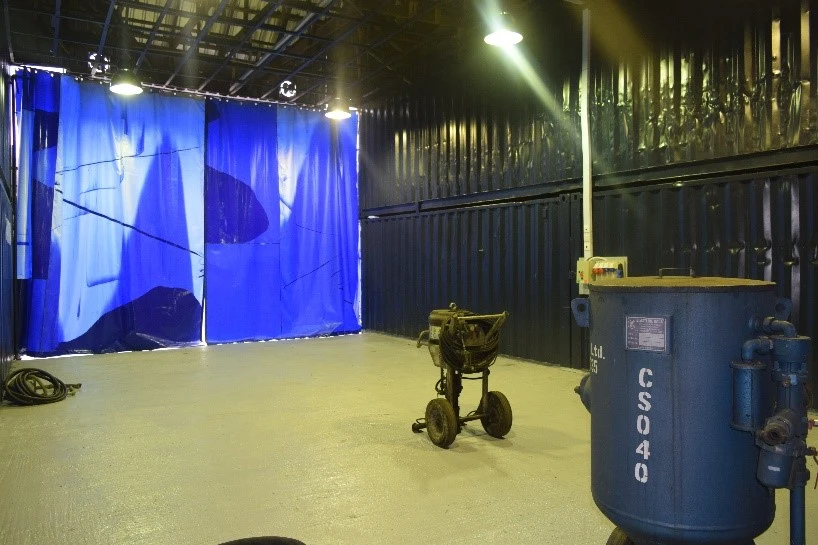SAFETY CHECKLIST FOR DRY ABRASIVE BLASTING

Safety Checklist for Dry Abrasive Blasting
According to NACE International, an estimate of 60%-80% of all premature coating failures are attributed to inadequate or improper surface preparation. Surface preparation is the process of removing contaminants from a structure. These contaminants include corroded surfaces, welding defects, oil, grease, dirt, amongst others. There are several methods of surface preparation, and a prominent one is the Dry Abrasive Blasting method.


What is Dry Abrasive Blasting?
The Dry Abrasive blasting method entails the use of either metallic or nonmetallic abrasives for descaling or removal of rust from a corroded surface. This is one of the best and most common forms of surface preparation before the application of coating/Paints. The abrasives come in different sizes depending on the profile required for each coating/paint.
While carrying out the Dry Abrasive method of surface preparation, it is important to adhere to the following safety checklists:
- Use Correct safety gears (PPE): The use of safety gears and personal protective equipment (PPE) is imperative to sustaining personal health and safety while getting the job done. PPE is an equipment that will protect workers against health or safety risks on the job. This includes but not limited to;
- Respiratory: Personnel carrying out abrasive blasting operation are to wear NIOSH-certified respirators appropriate for the types and concentrations of airborne contaminants present during abrasive blasting. The respirator selected should be based on the highest anticipated exposures as determined by an evaluation of the hazards to which personnel will be exposed. OSHA recommends that an abrasive-blasting respirator must cover the wearer’s head, neck, and shoulders to protect the wearer from rebounding abrasive.
- Eye and face protection: If this is not provided for in the design of the respirator, then a safety goggle with a face shield should be used. Personnel around the area of blasting operation should also wear a safety google with a face shield.
- Blast Helmet: If this is not provided for in the design of the respirator, a blaster must wear a safety helmet.
- Apron or blast suit: Blasters must wear a heavy-duty blast suit to protect the worker’s entire body (especially arms and front of the body) from the impact of abrasive particles.
- Blast Gloves: Gloves of high dexterity and durability with an extra-long cuff to protect the forearm should be worn by blasters.
- Safety boots: protective footwear made of tough materials with steel tip to prevent to protect toes from cuts, punctures, and impact
- Hearing protectors: If this is not provided for by the design of the respirator, then operators and other workers on site must wear comfortable earmuffs to reduce noise levels and protect their hearing.
- CPF UNIT: The filters in the CPF units must be changed based on usage to prevent the operators from using contaminated air supply.
- Carbon dioxide monitor has to be connected to the CPF unit to check for the presence of CO gases in the air supply.
- Proper House Keeping: There should be proper housekeeping in the blasting area with keen attention to trip and slip hazards. Proper housekeeping helps prevent incidents and injuries, consequently leading to low “Loss Time Incidence” while increasing productivity.
- Isolation and Containment of the blasting area: Barriers and curtain walls should be used to isolate the blasting operation from other workers on site. The use of blast rooms or blast cabinets for smaller operations is recommended. Also, best practices encourage the use of restricted areas for non-enclosed blasting operations. This is to keep coworkers away from the blaster.

- Ventilation: Blast room or cabinet should be adequately ventilated. Ventilation helps the blast rooms or cabinets to get rid of smoke and pollutants derived from the dry blasting process. A proper blast room ventilation system will help expel a buildup of pollutants replacing it with clean air to decongest the blast room or cabinet.
- Personnel Training:
Training should be provided to abrasive blasters and support personnel on blasting health and safety hazards, how to use controls, personal hygiene practices, safe work practices and the use of PPE and respirators. The manufacturer’s health hazard information on the blasting materials on safety data sheets (SDS) should be read by the personnel involved in blasting.
The risk associated with dry abrasive blasting can be minimized when the correct safety gears (PPE) are worn, correct equipment used, required procedures followed and standards maintained.

JC International team uses a range of surface preparation techniques including grit blasting, hydro blasting, and bristle brushing to provide the required surface finish in readiness for the application of corrosion control methods both onshore and offshore.
To request for any of our services, kindly contact our team on +234-8076291170 or send an email to: ndt@jcinternationalng.com

Leave a Reply